Antenna Market Research, 2032
The global antenna market was valued at $16.8 billion in 2022 and is projected to reach $40.1 billion by 2032, growing at a CAGR of 9.1% from 2023 to 2032.
An antenna plays a vital role within communication systems that help to send and receive electromagnetic waves such as radio frequencies (RF), microwaves, and even light. Its core purpose involves converting electrical signals into electromagnetic waves for propagation into the surrounding space, or the opposite conversion of received electromagnetic waves into electrical signals that electronic devices process. Antennas come in various sizes and shapes, optimized for specific applications and frequency ranges. Their significance spans a wide spectrum of devices, ranging from everyday items such as wireless communication, smartphones, radio towers, radio telescopes, and TVs to sophisticated setups such as radar installations and satellite communications.
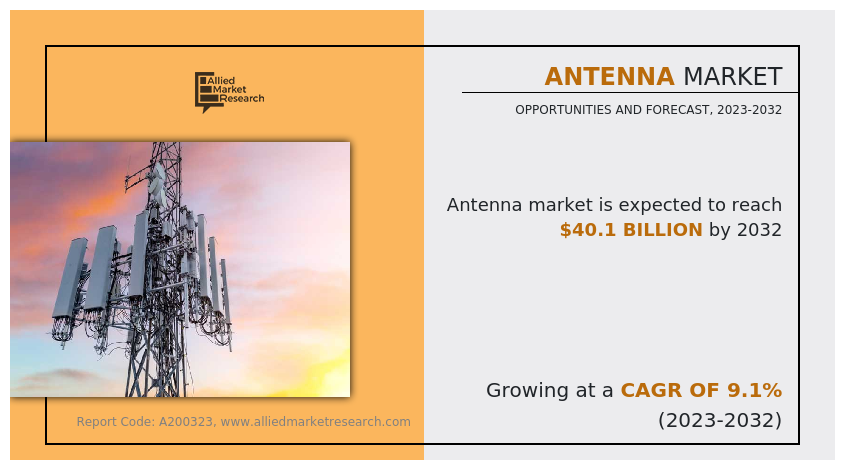
The antenna industry has rapidly evolved with upcoming technologies. One prominent trend involves incorporating advanced techniques such as beamforming and phased-array methods into 5G networks. These methods enable dynamic manipulation of antenna patterns, leading to enhanced signal quality, minimized interference, and increased capacity. In addition, antennas based on metamaterials have gained popularity, offering compact designs with tailored electromagnetic characteristics that are customized for specific uses, such as medical imaging, security screening, and wireless power transfer. In the field of satellite communication, electronically adjustable antennas are emerging, allowing satellites to swiftly adapt their coverage and connectivity to cater to various regions and applications.
Antennas find applications across diverse domains. In the realm of consumer electronics, they are indispensable for wireless devices such as smartphones, laptops, and tablets, ensuring seamless connectivity. In the automotive sector, antennas facilitate communication between vehicles (V2V) and between vehicles and infrastructure (V2I), supporting autonomous driving and traffic management systems. Satellite communication heavily relies on antennas for data transmission and reception, contributing to global connectivity, weather monitoring, and navigation. The Internet of Things (IoT) utilizes antennas to link an array of devices, from smart home gadgets to industrial sensors, enabling effortless data exchange and automation. The antenna technology serves various end-users, benefiting individuals, industries, and governments alike. From everyday consumers using mobile devices for communication and navigation to industries applying antennas for efficient logistics, healthcare monitoring, and agriculture, the impact of the technology is widespread. Furthermore, public safety agencies and disaster response teams depend on antennas for effective communication during crises, underscoring their crucial role in protecting communities.
Market Segmentation
The antenna market is segmented into Technology Type, Application, and End User.
On the basis of technology type, the market is bifurcated into SIMO, MIMO, MISO, and Others. In 2022, the MIMO segment dominated the market, and it is expected to acquire a major market share by 2032.
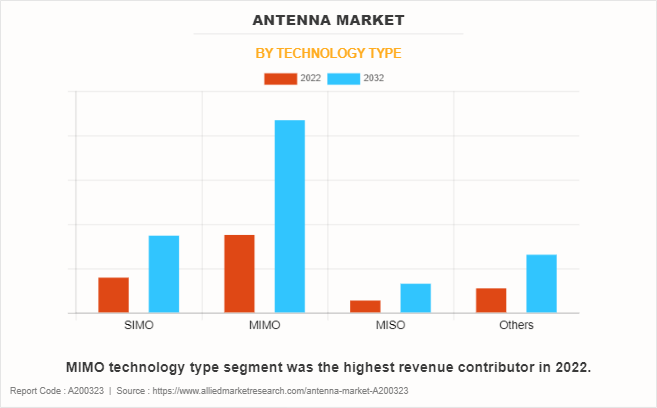
On the basis of application, the market is categorized into cellular systems, radar, WiFi systems, and others. The cellular systems segment acquired the largest share in 2022 and the radar segment is expected to grow at a significant CAGR from 2023 to 2032.
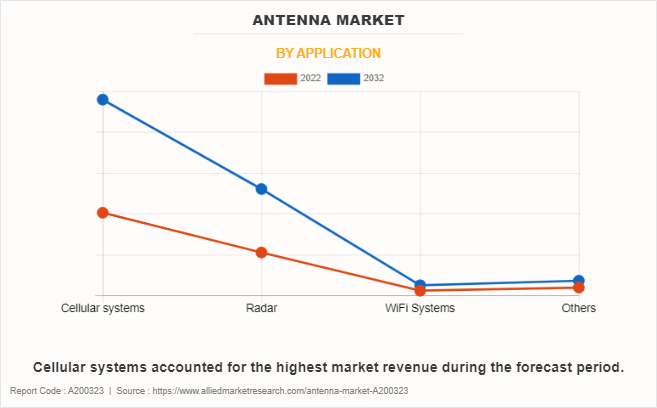
On the basis of end users, the antenna market size is categorized into consumer electronics, healthcare, aerospace and defense, telecommunication, and others. The telecommunication segment acquired the largest share in 2022 and it is expected to grow at a significant CAGR from 2023 to 2032.
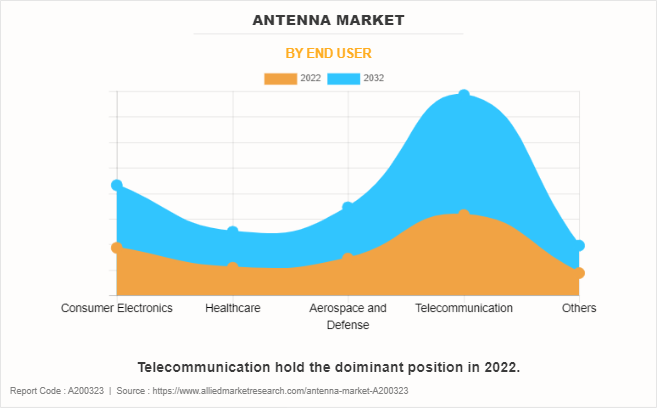
On the basis of region, the antenna market trends are analyzed across North America (the U.S., Canada, and Mexico), Europe (the UK, Germany, France, and the rest of Europe), Asia-Pacific (China, Japan, India, South Korea, and rest of Asia-Pacific), and LAMEA (Latin America, Middle East, and Africa).
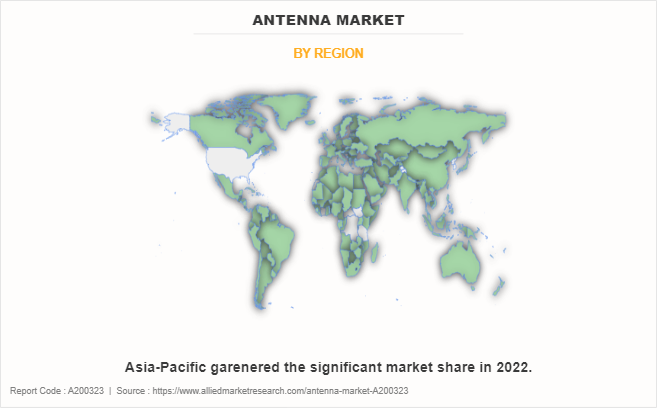
Competitive Analysis
Competitive analysis and profiles of the major global antenna market players that have been provided in the report include Amphenol Corporation, Antcom, Antenova Ltd., Molex (Koch Industries), Panorama Antennas, PCTEL, Pulse Electronics (YAGEO Group), Shenzhen Xinwei Communication Co., Ltd., STI-CO, and TE Connectivity. The key strategies adopted by the major players in the antenna market are product launch, acquisition, and expansion.
Country Analysis
Country-wise, the U.S. acquired a prime share in the antenna market forecast in the North American region and it is expected to grow at a significant CAGR during the forecast period of 2023-2032.
In Europe, the UK, dominated the antenna market share, in terms of revenue, in 2022 and is expected to follow the same trend during the forecast period. However, Germany is expected to emerge as the fastest-growing country in Europe's antenna market with a CAGR of 9.4%.
In Asia-Pacific, China, is expected to emerge as a significant market for the Antenna market industry, owing to a significant rise in investment by prime players due to an increase in the growth of consumer electronics in rural and urban regions.
In the LAMEA region, Latin America garnered a significant market share in 2022. The LAMEA Antenna market has witnessed an improvement, owing to the growth in the inclination of prime vendors towards utilizing the antenna across this region in various applications such as healthcare, automotive, and others. Moreover, the Latin America region is expected to grow at a high CAGR of 8.46% from 2023 to 2032.
Top Impacting Factors
The antenna market outlook is expected to witness notable growth during the forecast period, owing to an increase in the adoption of chip antennae in the Internet of Things devices, and the increase in the adoption of chip antennae in the consumer electronics industry drives the market growth. Moreover, the development of 5G is expected to provide lucrative opportunities for the growth of the antenna market during the forecast period. On the contrary, the lack of uniform frequency range for wireless applications is the restraint for antenna market growth during the forecast period.
Historical Data & Information
The global antenna market is highly competitive, owing to the strong presence of existing vendors. Vendors of the antenna market with extensive technical and financial resources are expected to gain a competitive advantage over their competitors because they can cater to market demands. The competitive environment in this market is expected to worsen as technological innovations, product extensions, and different strategies adopted by key vendors increase.
Key Developments/ Strategies
Amphenol Corporation, Antcom, Antenova Ltd., Molex (Koch Industries), Panorama Antennas, PCTEL, Pulse Electronics (YAGEO Group), Shenzhen Xinwei Communication Co., Ltd., STI-CO, and TE Connectivity. are the top companies holding a prime share in the antenna market. Top market players have adopted various strategies, such as product launch, acquisition, and expansion to expand their foothold in the antenna industry.
- In August 2023, PCTEL, Inc. a leading global provider of wireless technology solutions, announced its new 5G FR1 Omnidirectional antenna optimized for Industrial IoT applications.
- In February 2023, PCTEL, Inc., a leading global provider of wireless technology solutions, announced its new VerStack antenna platform for smarter rail communications and IIoT applications.
- In September 2022, PCTEL, Inc., a leading global provider of wireless technology solutions, announced its new MultiFin configurable antenna for public safety, fleet management, and intelligent transportation applications.
- In August 2023, Amphenol RF announced the launch of its embedded antennas into the antennas portfolio. These surface-mounted chip antennas offer excellent electrical performance up to 8.5 GHz. The chip antenna supports cellular 4G/5G-FR1 frequencies along with Wi-Fi and Bluetooth/BLE and LoRa, UWB, and GNSS. Embedded RF antennas are ideal for IoT and smart devices due to their compact size and durable construction.
- In March 2023, Amphenol RF announced the launch of its external antennas to its product portfolio as a direct complement to existing RF interfaces providing a complete solution from application to antenna. External antennas connect to familiar interfaces such as SMA, RP-SMA, and N-Type and are available in single, dual, and wide-band configurations. These antennas are widely used in Bluetooth, wireless protocols, WLAN/WWA, and IoT applications.
Key Benefits For Stakeholders
- This report provides a quantitative analysis of the market segments, current trends, estimations, and dynamics of the antenna market analysis from 2022 to 2032 to identify the prevailing antenna market opportunity.
- The market research is offered along with information related to key drivers, restraints, and opportunities.
- Porter's five forces analysis highlights the potency of buyers and suppliers to enable stakeholders to make profit-oriented business decisions and strengthen their supplier-buyer network.
- An in-depth analysis of the antenna market segmentation assists in determining the prevailing market opportunities.
- Major countries in each region are mapped according to their revenue contribution to the global market.
- Market player positioning facilitates benchmarking and provides a clear understanding of the present position of the market players.
- The report includes an analysis of the regional as well as global antenna market trends, key players, market segments, application areas, and market growth strategies.
Antenna Market Report Highlights
| Aspects | Details |
| Market Size By 2032 | USD 40.1 billion |
| Growth Rate | CAGR of 9.1% |
| Forecast period | 2022 - 2032 |
| Report Pages | 235 |
| By Technology Type |
|
| By Application |
|
| By End User |
|
| By Region |
|
| Key Market Players | Amphenol Corporation, Shenzhen Xinwei Communication Co., Ltd., Pulse Electronics Corporation, Antenova Ltd., STI-CO, TE Connectivity Ltd., Molex, PCTEL, Inc., Antcom Corporation, Panorama Antennas |
Analyst Review
The antenna industry stands to experience substantial advantages and progress in the coming years, across a wide range of applications and user groups. The surge in wireless technologies such as 5G, Internet of Things (IoT), and satellite communications are expected to stimulate the need for advanced antennas capable of offering faster data speeds, enhanced connectivity, and broader coverage. As these technologies continue to evolve, antennas are anticipated to play a pivotal role in ensuring smooth communication for both personal and industrial devices. For example, the implementation of 5G networks necessitates a higher density of antennas to accommodate increased frequencies and data rates, driving a heightened demand for compact cell and massive MIMO antennas that serve densely populated urban regions.?
In addition, the expansion of self-driving vehicles and intelligent transportation systems are anticipated to further propel the antenna market growth. Antennas are indispensable for facilitating communication between vehicles (V2V) and between vehicles and infrastructure (V2I), enabling real-time data exchange for safe and efficient driving. With the automotive sector transitioning toward more interconnected and autonomous vehicles, the requirement for specialized antennas optimized for vehicular communication and navigation systems is projected to experience growth.?
Furthermore, the surge in integration of IoT devices across diverse industries, spanning healthcare, agriculture, manufacturing, and logistics, is anticipated to foster a need for a variety of antennas tailored to specific purposes. These antennas are expected to deliver reliable connectivity and coverage in intricate environments, contributing to heightened efficiency, data gathering, and overall performance within these sectors.?
On the basis of region, the antenna market trends are analyzed across North America (the U.S., Canada, and Mexico), Europe (the UK, Germany, France, and rest of Europe), Asia-Pacific (China, Japan, India, South Korea, and rest of Asia-Pacific), and LAMEA (Latin America, Middle East, and Africa).?
Competitive analysis and profiles of the major global Antenna market players that have been provided in the report include Amphenol Corporation, Antcom, Antenova Ltd., Molex (Koch Industries), Panorama Antennas, PCTEL, Pulse Electronics (YAGEO Group), Shenzhen Xinwei Communication Co., Ltd., STI-CO, and TE Connectivity. The key strategies adopted by the major players of the Antenna market are product launch, acquisition, and business expansion.
Increase in adoption of chip antenna in Internet of Things devices, and increase in adoption of chip antenna in consumer electronics industry drives the antenna market growth.
Cellular systems is the leading application of Antenna Market.
Asia-Pacific is the largest regional market for Antenna.
The global antenna market was valued at $16,798.12 million in 2022.
Amphenol Corporation, Antcom, Antenova Ltd., Molex (Koch Industries), Panorama Antennas, PCTEL, Pulse Electronics (YAGEO Group), Shenzhen Xinwei Communication Co., Ltd., STI-CO, and TE Connectivity are the top companies to hold the market share in Antenna.
Loading Table Of Content...
Loading Research Methodology...



